Diction is a powerful tool that can be used to enhance writing and tone, allowing us to convey meaning with very precise language.
Using diction can help authors and speakers make their literary works and professional texts more interesting and impactful to their audiences.
It should be used carefully, however, as it can become too distracting or vague if overdone. It can also alienate readers. The key is to choose your words wisely and use them in appropriate contexts.
This article will dive into diction examples to help readers understand what diction is, the different types of diction, and how to apply them.
We’ll look at some classic literary examples of how authors have utilized different types of diction to create a specific style and tone in their writing.
After reading this article, you will have a better understanding of how to use diction in your own writing.
What is Diction?

Diction is a literary device that refers to the choice of words used in literature, poetry, speech, or other forms of communication.
Diction expresses an author’s attitude towards their subject matter and is used to create a specific atmosphere and tone, such as irony or humor.
When used strategically, it can emphasize moods and feelings, convey character traits, enhance descriptions, and add rhythm to your writing.
It can refer to both the denotative (literal) meanings of words, as well as their connotative (emotional) associations.
In order to be effective, diction must fit both its content (what it is about) and context (where it appears).
For example, writing about a historical event may require more formal language than discussing everyday life. Similarly, using humor may require certain types of words that would not be suitable for a solemn moment.
Diction can also be seen in oral communication such as speeches or debates.
For example, politicians may use rhetorical devices like alliteration or repetition to emphasize certain points. Preachers may use literary techniques like metaphor or simile to make their sermons more powerful.
10 Types of Diction With Examples
By understanding the different types of diction, writers can choose the right words to more accurately convey their intended message. Whether you need to use formal or informal language, scientific terms or colloquialisms, there is a type of diction for every occasion!
1. Formal Diction

Formal diction, as it sounds, is language that is considered formal. It’s often used in academic writing or professional settings, where people need to be polite and respectful when they speak.
It may also include complex terminology and vocabulary not commonly used in everyday conversation or be used to express a thought or statement in a more formal way.
Let’s say that you were asked if you agree to the terms presented in a contract that you were expected to sign.
An example of formal diction in response would be, “I find the items to be acceptable.”
In contrast, a response in informal diction would sound more like “Sure thing!” or “Absolutely!”
2. Informal Diction

Informal diction is casual language more typically heard in day-to-day conversations in speech or writing. It includes slang, colloquialisms, and other terms that may not be appropriate in more formal situations.
Examples of informal diction could include phrases like “Let’s hit the road,” or “This is a no-brainer.”
3. Poetic Diction
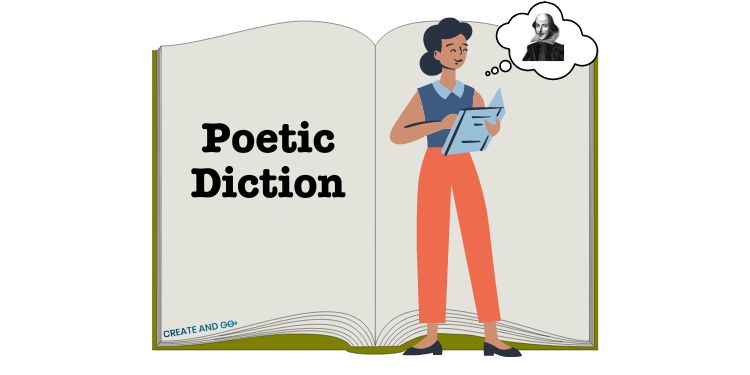
Poetic diction is a type of writing used in literature, novels, short stories, and poetry. It refers to specific word choices tailored to evoke an emotional response from the reader or listener.
The words chosen by writers are typically more imaginative than what is commonly heard in everyday language, as many poetic devices rely on creative phrasing to highlight a certain point. An example of poetic diction could be, “The moonlight illuminated the room with its silvery grace.”
4. Colloquial Diction
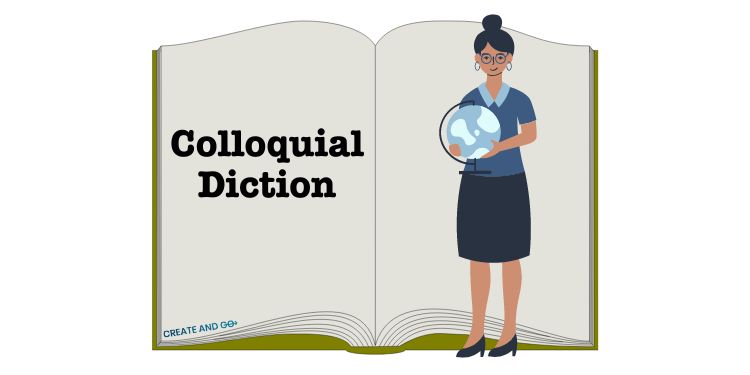
Colloquial diction is language specific to a certain region or location. It’s often informal and may include slang terms, idioms, contractions, and other regional expressions that may not be commonly understood in other locations or settings.
An example would. be, “Y’all better get to the store before it closes.” Other examples of colloquial words from American English include “duds,” “junk food,” and “That’s my jam!”
5. Slang Diction
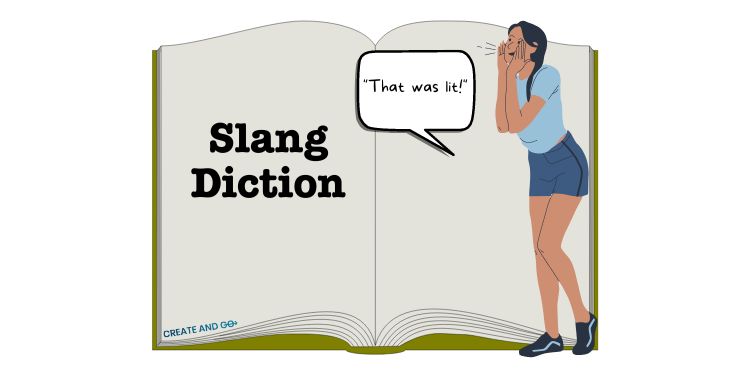
Slang diction is informal language that includes made-up words, new meanings for existing words, and creative phrasing. It’s often used in popular culture to express certain ideas or feelings in a unique way.
Slang diction may vary depending on the region or culture, so it’s important to take context into consideration before using certain terms. For example, “lit” is a slang word used to describe something cool or exciting.
Another example of slang diction is, “I’m gonna hit up the club tonight.”
6. Concrete Diction
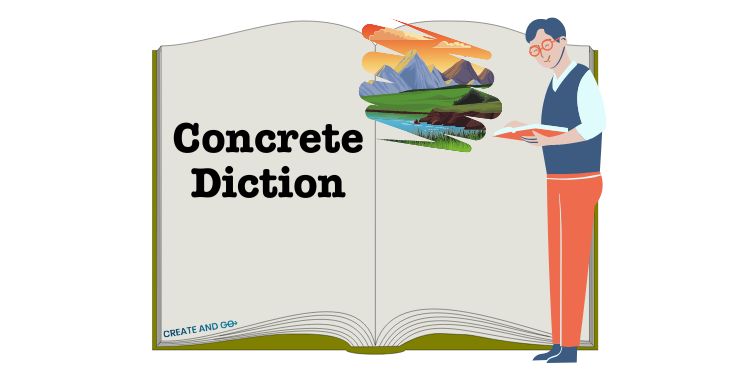
Concrete diction is used to describe an object, person, or event in a detailed way. It uses vivid imagery and precise words that allow the reader to visualize the scene without having to use any additional context.
An example of concrete diction could be, “The fire was roaring from the hearth, its flames glowing brightly in the darkness.”
7. Abstract Diction

Abstract diction is when writers use general terms to describe an object, person, or event. It’s the opposite of concrete, which uses more specific words to paint a vivid picture.
An example of abstract diction could be, “The night was dark and cold.” This sentence gives the reader a general idea of what it’s like outside, but it doesn’t provide any details for the reader to visualize the scene in their mind.
8. Pedantic Diction

Pedantic diction is an exaggerated form of formal language. It’s when someone uses overly long words to make them sound more knowledgeable or incisive.
The speaker may use a complex sentence structure or string together multi-syllable words in an effort to show off their vast vocabulary. An example of pedantic diction would be, “I find it rather disconcerting that he should behave in such a manner.”
9. Scientific Diction
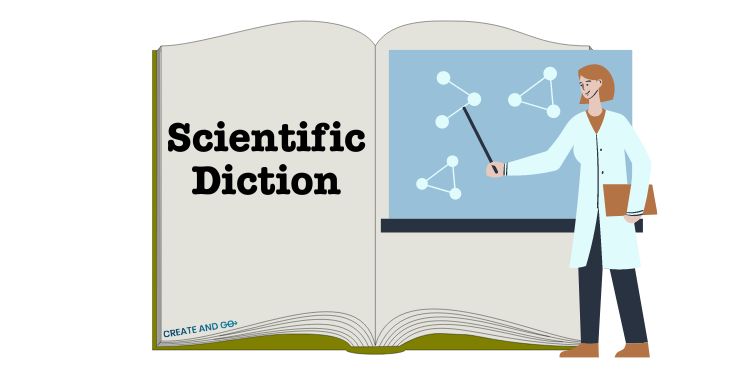
As the name implies, scientific diction is used to describe technical concepts that you would find in research papers and scientific studies. It typically includes terms and words related to a specific field of study or discipline, such as biology, chemistry, physics, etc.
An example of scientific diction could be, “The scientist observed the compound rendered inert with an alkali solution.” This sentence is conveying a very specific process using precise terminology that would only make sense to someone familiar with chemistry.
10. Neutral Diction

Neutral diction is language that isn’t biased and doesn’t express any opinion or emotion. It’s often used in academic settings, business presentations, or other formal contexts when it’s important to be objective and non-judgmental.
An example of neutral diction would be, “The company reported decreased profits for the third quarter.” There is no judgment being expressed here, just a simple fact.
Terms Related to Diction
In literature, diction is closely related to other stylistic elements such as syntax, imagery, metaphors, and more. Here are a few common literary terms related to diction:
- Jargon: specific words used by particular groups or professions, such as “technical jargon” or “scientific jargon”
- Dialect: words used in a particular area or region, such as “Southern dialect” or “New York dialect”
- Alliteration: using words with the same initial consonant sound, such as “proud panda” or “little lamb”
- Assonance: repeating vowel sounds in nearby words, such as “breeze through these trees” or “the sea swell’s serene crest”
- Hyperbole: extreme exaggeration used for effect, like saying someone is running “faster than lightning”
- Metaphor: comparing two unlike things without using the words “like” or “as,” such as referring to a person as a “scorpion” to signify danger
- Personification: giving non-human objects human qualities, like referring to a car as having “angry eyes”
Popular Diction Examples
Examples of Diction in Literature
Diction is used to evoke emotion and convey meaning in many different types of literature. Here are some diction literary examples:
1. The Adventures of Huckleberry Finn by Mark Twain
Huck’s use of colloquial diction creates an authentic atmosphere in the book. Huck uses words like “ain’t,” “all right then,” and “reckon so” to give readers a sense of what life was like during the time period.
2. Hamlet by William Shakespeare
Hamlet’s use of scientific diction reflects his intelligence and knowledge of particular subjects. He often uses terms like “philosopher” and “anatomy” to convey his sophisticated understanding of the world.
3. The Catcher in the Rye by J.D Salinger
Holden Caulfield’s use of slang diction creates a unique voice and captures the teenage spirit of the character. He uses words like “phony” and “crumby” to express ideas in a more youthful way.
4. A Tale of Two Cities by Charles Dickens
Dickens’ use of concrete diction allows readers to vividly imagine the settings and characters in his book. He uses words like “ragged” and “dimly lit” to give a more detailed picture of the scenes he is describing.
5. The Great Gatsby by F. Scott Fitzgerald
Fitzgerald’s use of abstract diction creates a dream-like atmosphere in the novel. He uses words like “mysterious” and “enchanting” to give readers a feeling of being in an alternate reality.
6. Romeo and Juliet by Shakespeare
Shakespeare’s use of poetic diction brings the characters alive in the play. He uses phrases like “But soft! What light through yonder window breaks?” and “Parting is such sweet sorrow” to convey emotion and beauty.
Examples of Diction in Film and Television
The same principles of diction also apply to film and television.
1. The Office
The characters in The Office often use pedantic diction to express their superiority or knowledge on particular subjects. For example, Michael Scott will say things like “I am aware of the parameters of my job description” or “This seminar will allow us to delve into the depths of our professional repertoire.”
2. The Big Bang Theory
The characters in The Big Bang Theory often use scientific diction to show off their intelligence. For example, Sheldon Cooper will say things like “I’m developing a mathematical model to calculate the optimal seating arrangement for our group” or “I’m attempting to reverse engineer the molecular structure of a cilantro-based salsa.”
3. Friends
The characters in Friends often use neutral diction to give their conversations a more natural, conversational tone. For example, they will say things like “I have to work late tonight” or “I’m really tired today.”
4. The Simpsons
The characters in The Simpsons often use colloquial diction to create a more humorous atmosphere. For example, they will say things like “Oh dear, I’m in a pickle” or “I need a break from all this tomfoolery.”
5. Stranger Things
The characters in Stranger Things often use abstract diction to create a sense of mystery and suspense. For example, they will say things like “It feels like something dark is coming” or “There’s an eerie feeling in the air tonight.”
FAQs About Diction
Key Takeaways for Using Examples of Diction
Diction can be used to convey different styles, tones, emotions, and ideas in literature and writing.
By understanding the different types of diction and related terms, you can gain a greater appreciation for how authors use language to create unique stories.
You can also get a better understanding of how to use language appropriately in your own writing or speech. For example, informal words don’t always have a place in formal writing.
From formal, sophisticated language to informal slang, each writer has their own unique writing style and use of words and a specific time and place to use certain words.